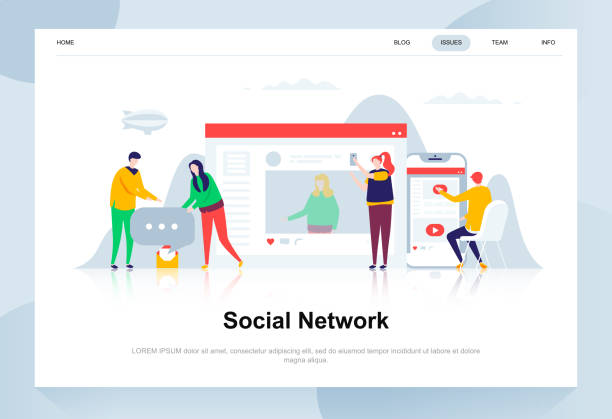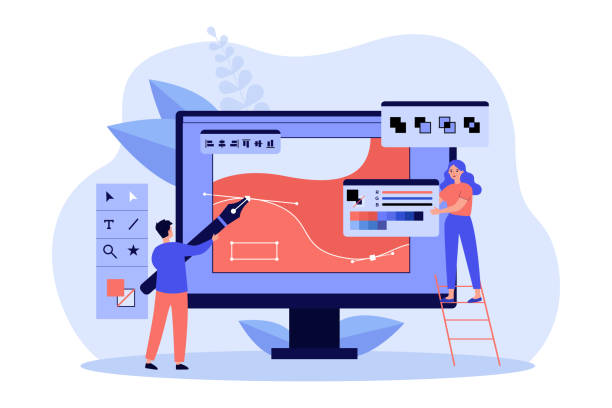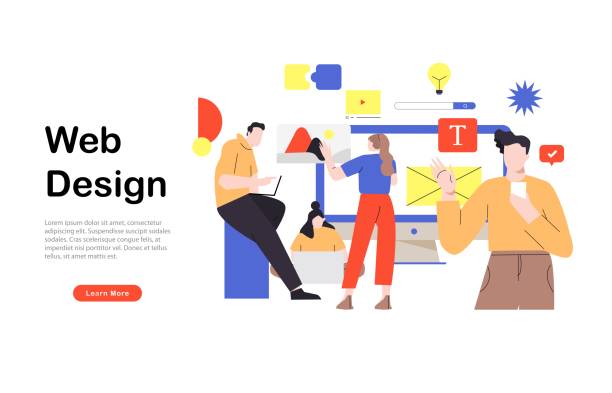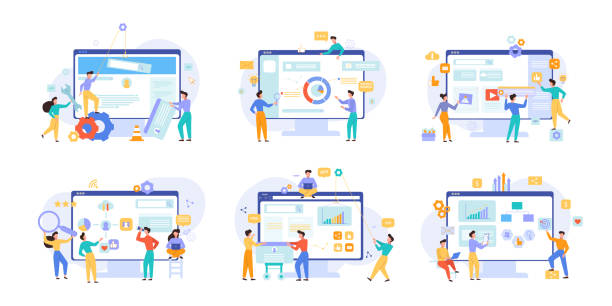Introduction and the Importance of Creating an Online Store

In today’s world, where geographical boundaries have lost their meaning, e-commerce website design is no longer a luxury choice, but a necessity for any business seeking growth and survival in a competitive market.
From a small local shop to a large international brand, having a strong platform for e-commerce can open new doors to customers and markets.
This allows businesses to offer their products and services 24 hours a day, 7 days a week to audiences, without time and location constraints.
The importance of this is not only in increasing sales but also in building a strong brand, enhancing credibility, and accessing valuable customer data to improve marketing strategies.
Creating an online store allows you to reach a wider audience with much lower costs compared to a physical store, and even compete globally.
To start this journey, a clear understanding of #customer_needs, #business_goals, and #technical_platforms is essential.
The goal of this article is to provide a comprehensive and specialized guide for anyone looking to design an e-commerce website and wants to benefit from its countless advantages.
We will help you become familiar with the key concepts and fundamental steps in this field.
Are you tired of your e-commerce site having visitors but no sales? Rasawweb solves your main problem with professional e-commerce website design!
✅ Significant sales increase with targeted design
✅ Flawless user experience for your customers
⚡ Get a free consultation!
Essential Steps for Designing a Successful E-commerce Website

E-commerce website design is a complex yet manageable process that involves several key stages.
The first step is thorough research and planning.
This stage includes defining the store’s main goal, identifying target audiences, competitor analysis, and market research.
Next, it’s time to choose a suitable domain name and hosting, both crucial for optimal performance and site speed.
The domain should be memorable and relevant to your business, while the host should provide high speed and security.
The next step is selecting the right platform.
There are various options such as WordPress with WooCommerce, Shopify, Magento, etc., each with its own advantages and disadvantages, and their selection depends on your needs and budget.
After platform selection, the user interface (UI) and user experience (UX) design phase begins.
This specialized section involves creating an appealing visual appearance and simple navigation for users so they can easily find products, add them to the cart, and complete the payment process.
Finally, the stages involve development, adding products, configuring payment and shipping methods, and final site testing.
This educational and complex process requires precision and attention to detail to ensure the website functions correctly and without issues.
Each step must be executed with great care to create an efficient and successful e-commerce website.
Popular Platforms for Designing and Building an Online Store

Choosing the right platform is one of the most important decisions in the e-commerce website design journey.
This choice directly impacts development capabilities, ease of management, costs, and even the future scalability of your business.
Platforms are divided into two main categories: Open-Source and Cloud (SaaS).
Among open-source platforms, WooCommerce, a WordPress plugin, is undoubtedly the most popular option.
Due to its high flexibility, countless plugins and themes, and a large user community, this platform is suitable for a wide range of businesses.
Its initial cost is relatively low, but for complex customizations and high scalability, you may need more technical knowledge.
Magento is also a powerful and specialized open-source platform suitable for large stores with complex needs, but it is more difficult and expensive to learn and manage.
In the cloud platform category, Shopify is an excellent choice for small and medium-sized businesses looking for a quick and easy store setup.
This platform offers a good user experience with a simple user interface, built-in marketing tools, and strong support, but you have less control over the code and server, and its monthly costs can be high in the long run.
Here is an analytical table comparing some of these platforms:
| Platform | Type | Ease of Use | Flexibility | Initial Cost | Suitable For |
|---|---|---|---|---|---|
| WordPress + WooCommerce | Open-Source | Medium | Very High | Low | All types of businesses, needing more control |
| Shopify | Cloud (SaaS) | High | Medium | Medium (monthly) | Small and medium businesses, quick setup |
| Magento | Open-Source | Low | Very High | High | Large and complex stores |
Choosing the right platform plays a vital role in the process of creating an e-commerce website and should be based on your business’s needs and long-term strategy.
User Experience (UX) and User Interface (UI) in E-commerce Website Design

In the discussion of e-commerce website design, User Experience (UX) and User Interface (UI) are of high importance.
UI refers to the visual appearance and feel of the site (colors, fonts, button layout), while UX focuses on the overall user experience from the moment they enter the site until they complete a purchase.
An attractive UI and a smooth UX can directly impact conversion rates and customer satisfaction.
A successful online store design should include simple and intuitive navigation so users can easily find the products they are looking for.
Using advanced filters, strong search capabilities, and clear product categories are key points in this regard.
Also, product pages should be descriptive and include high-quality images, detailed descriptions, customer reviews, and information regarding stock and shipping.
The payment process should also be as simple and fast as possible to prevent cart abandonment.
This specialized and guidance section also highlights the importance of Responsive Design; meaning your site should display well on different devices (mobile, tablet, desktop).
Ultimately, attention to small details such as page load speed and error messages can significantly improve the user experience and contribute to the success of your online sales platform.
Are you concerned about your e-commerce site’s low conversion rate and not achieving your desired sales?
Rasawweb is your specialized solution for a successful e-commerce website.
✅ Significant increase in conversion rate and sales
✅ Professional and user-friendly design to attract customer satisfaction
⚡ Ready for a transformation in online sales? Get a free consultation!
SEO for Increasing Online Store Traffic

SEO (Search Engine Optimization) is one of the most vital aspects in e-commerce website design that ensures its long-term success.
Without strong SEO, even the best products may not be seen among a multitude of competitors.
The main goal of SEO is to increase your site’s visibility in Google search results and other engines to drive more organic (free) traffic to your store.
This includes optimizing keywords, URL structure, meta descriptions, and page titles.
For an online store, product and category SEO is particularly important.
Each product page should be optimized with relevant keywords and contain unique and engaging content.
Site speed, also known as Core Web Vitals, is an important ranking factor; slow sites not only provide a poor user experience but also rank lower in search results.
Internal Linking and Backlinking also play a significant role in site authority and ranking.
This is a specialized and educational section that requires continuous follow-up.
Regular analytical and news content such as blog articles or buying guides can help attract new traffic and improve SEO.
In general, the stronger your e-commerce website is in terms of SEO, the higher your chances of attracting potential customers and converting them into buyers.
Remember that SEO is an ongoing process and requires updates and adaptation to new Google algorithms.
Google’s SEO Starter Guide is a good resource for more information.
Security and Payment Protocols in Online Stores

One of the most important concerns for users and business owners in e-commerce website design is security.
Ensuring the security of customers’ personal information and payment details is crucial for building trust and maintaining brand reputation.
Using an SSL certificate (Secure Sockets Layer) is the first and most fundamental step.
SSL encrypts information between the user’s browser and the website server, preventing eavesdropping by malicious individuals.
The presence of an address with “https://” and a lock symbol in the browser’s address bar indicates the use of SSL and reassures customers.
In addition to SSL, selecting secure and reputable payment gateways is also highly important.
These gateways must comply with PCI DSS (Payment Card Industry Data Security Standard).
Integration with well-known and reliable payment systems such as Zarinpal, NextPay, or direct bank gateways makes the payment experience both easier and more secure for customers.
For an online store, implementing strong firewalls, regularly updating systems and plugins, and performing regular data backups are other specialized security measures.
Also, clear and specific privacy policies for users build their trust.
Any security breach can quickly harm the reputation of your electronic business.
Educating users about the importance of creating strong passwords and warning about phishing attacks can also be part of a comprehensive security approach.
This guidance ensures that your e-commerce site development process is carried out with a focus on customer data security.
Maintenance and Updates of an E-commerce Website

E-commerce website design is just the beginning; regular maintenance and updates are crucial for long-term performance, security, and efficiency.
A dynamic online store requires continuous attention to keep up with technological changes and provide an optimal user experience.
This maintenance includes several important aspects.
The first and most important aspect is updating software and plugins.
E-commerce platforms like WordPress with WooCommerce or Magento, as well as all plugins and themes used, are constantly updated to provide security improvements, bug fixes, and new features.
Neglecting these updates can make your site vulnerable to cyberattacks or cause functional incompatibilities.
The second aspect is regular data backups.
Losing product information, customer orders, or user data can be catastrophic.
Planning for daily or weekly backups and storing them in secure locations (such as cloud storage or separate servers) is of high importance.
In addition, monitoring site performance, including page load speed, checking for broken links, and ensuring the correct functioning of all forms and the payment process, is also essential.
This educational and explanatory section helps you identify and resolve potential problems before they affect customer experience.
Preventive maintenance can avert larger issues and ensure that your online store system is always at its best.
Below is a table for a regular maintenance checklist:
| Maintenance Activity | Suggested Frequency | Importance |
|---|---|---|
| Platform Core Updates | Monthly / After new version release | High |
| Plugin and Theme Updates | Weekly / Monthly | High |
| Database and File Backups | Daily / Weekly | Very High |
| Check Broken Links | Monthly | Medium |
| Check Site Speed | Monthly | High |
| Security (Malware Scan, Firewall) | Weekly / Monthly | Very High |
| Check Form and Payment Gateway Functionality | Weekly | High |
| Delete Unnecessary Data/Cache | Monthly | Medium |
This continuous maintenance is an integral part of a successful e-commerce website design process.
Digital Marketing and Advertising for an Online Store

After completing e-commerce website design and launching it, comes the critical stage of attracting customers and increasing sales.
Digital marketing is a set of strategies and tactics that help you introduce your online store to target audiences.
One of the most powerful tools is Content Marketing.
Creating valuable content such as blog articles, buying guides, product introduction videos, and infographics not only helps with SEO but also builds customer trust and drives them towards making a purchase.
PPC (Pay-Per-Click) advertising on platforms like Google Ads and social media advertising (such as Facebook, Instagram, LinkedIn) are effective tools for driving targeted traffic to your online store.
These types of ads allow precise targeting of audiences based on their interests, demographics, and online behavior.
Email marketing also remains one of the most effective methods for retaining customers and informing them about new products, discounts, and special offers.
For an online sales platform, an active presence on social networks is very important for building a community of loyal customers and direct interaction with them.
Holding contests, surveys, and providing engaging content can help increase brand awareness and customer loyalty.
This analytical and guidance section emphasizes the importance of measuring and analyzing marketing campaign results for their continuous optimization.
Using tools like Google Analytics to track traffic, conversion rates, and customer behavior provides valuable insights for improving your marketing strategies and will significantly contribute to the success of your e-commerce website.
Don’t have a corporate website yet and missing out on online opportunities? With professional corporate website design by Rasawweb,
✅ Double your business’s credibility
✅ Attract new customers
⚡ Free consultation for your corporate website!
Data Analysis and Continuous Improvement of the Online Store

E-commerce website design is just an initial step; real success lies in your ability to analyze data and continuously improve store performance based on these insights.
Web analytics tools like Google Analytics provide valuable information about visitors, their behavior on the site, traffic sources, and the strengths and weaknesses of your store.
By analyzing this data, you can find answers to thought-provoking content questions such as “Where do customers come from?”, “Which products have the most views?”, “At which stage of the purchase process do customers leave the site?”.
Key metrics like Conversion Rate, Average Order Value, Bounce Rate, and Time on Site indicate the efficiency of your online store.
By regularly monitoring these metrics, you can identify weaknesses and take steps to improve them.
For example, if the bounce rate on product pages is high, you may need to improve images, product descriptions, or page navigation.
If the shopping cart abandonment rate is high, it can be reduced by simplifying the checkout process or offering diverse shipping options.
A/B testing is a specialized and analytical method that allows you to experiment with small changes in design or content to see which version performs better.
This data-driven approach helps you make better decisions for the continuous improvement of your e-commerce website.
Also, gathering direct feedback from customers through surveys, contact forms, and online chat provides valuable qualitative insights for improving the user experience.
This continuous optimization approach ensures that your e-commerce website is always growing and adapting to market needs.
Future Trends in Online Store Design and Development

The world of e-commerce is rapidly evolving, and awareness of future trends in e-commerce website design is crucial for maintaining competitiveness.
One of the most important upcoming trends is Personalization.
Customers expect an experience tailored to their tastes and needs; from product recommendations to customized content.
The use of Artificial Intelligence (AI) and Machine Learning (ML) to analyze customer data and provide intelligent suggestions will play an increasing role.
Voice Commerce is also growing.
With the increasing use of voice assistants like Siri and Alexa, the ability to purchase products through voice commands will become an important feature of future online stores.
This highlights the need for optimization for voice search and the design of Voice User Interfaces (VUIs).
Augmented Reality (AR) and Virtual Reality (VR) also have great potential to change how online shopping is experienced.
Customers can view products in their real environment before buying, such as trying on virtual clothes or placing furniture in their living room with AR.
These technologies can provide a more engaging and tangible experience for users and reduce return rates.
Also, Frictionless Payments and the use of Blockchain to increase security and transparency in transactions are other news and analytical future trends.
An e-commerce website design that considers these trends is ready to succeed in the coming decades and provide an unparalleled user experience.
Adapting to these changes and investing in new technologies is the key to success in the fast-paced world of online sales.
Frequently Asked Questions
| Question | Answer |
|---|---|
| What is e-commerce website design? | It is the process of building and developing a website for buying and selling products or services online. |
| What features should an e-commerce website have? | Product management, shopping cart, online payment gateway, user account section, product search and filter capabilities. |
| What is the importance of User Experience (UX) in e-commerce website design? | Good UX leads to easy navigation, a smooth purchasing process, and ultimately increases customer satisfaction and conversion rates. |
| Why is SEO important for an e-commerce website? | SEO helps your site rank higher in search engine results and attract more traffic, leading to more sales. |
| What platforms are available for e-commerce website design? | Ready-made platforms like WordPress (with WooCommerce), Shopify, PrestaShop, as well as custom design options are available. |
And other services of Rasa Web Advertising Agency in the field of advertising
- Smart Brand Identity: Designed for businesses seeking to increase website traffic through key page optimization.
- Smart Digital Branding: A dedicated service for growth in customer acquisition based on precise audience targeting.
- Smart Digital Branding: A combination of creativity and technology to increase sales through SEO-driven content strategy.
- Smart Website Development: An effective tool for online growth with the help of marketing automation.
- Smart Website Development: A dedicated service for online growth based on custom programming.
And over a hundred other services in the field of internet advertising, advertising consultation, and organizational solutions
Internet Advertising | Advertising Strategy | Advertorials
Sources
E-commerce Website Design Training from A to Z
10 Steps to Building a Successful E-commerce Website
Best E-commerce Platforms
Important Tips for UI and UX Design of E-commerce Websites
? Are you ready to transform your business in the digital world? At Rasaweb Afarin Digital Marketing Agency, with our expertise in user-friendly website design and implementing comprehensive digital strategies, we help you establish a powerful and effective online presence. From SEO and online advertising to social media management, we are your digital partner for achieving your goals.
📍 Tehran, Mirdamad Street, next to Bank Markazi, Kazeroun Jonoubi Alley, Ramin Alley, No. 6
